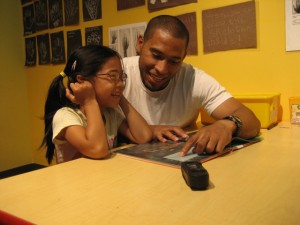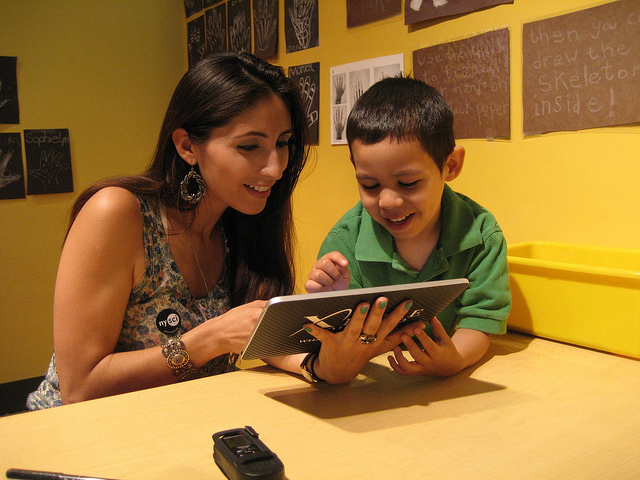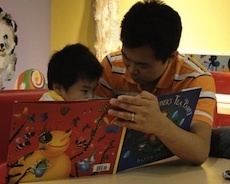Research Assistant Meagan Bromley reflects on our most recent time in the field for the Cooney Center’s E-Book QuickStudy. Find out what our research team has been up to lately as well as how you can get involved in our upcoming follow-up study this week!
“Oh yes, I read Miss Spider on the iPad at home, and I play other games on it too.”
– 5-year-old boy on the “game” of reading
When Sesame Street first began, researchers were interested in ways of encouraging “coviewing” between children audiences and their parents. The belief was that if parents watched the show with their kids and interacted with the reading and counting activities on the screen, children would learn more from the show (and have more fun!). Now we live in a digital age where children and parents are in front of a variety of screens — televisions as well as home computers, smart phones, iPads, e-readers, and so on. And while adults and children still engage in activities like reading and counting on these devices, they interact with each other and with these media in all sorts of new ways.
In line with our previous research on coviewing and intergenerational play, the research team at the Joan Ganz Cooney Center wants to get a sense of how interactions between adults and children are taking place when reading electronic books, or e-books. How do adults and children read e-books compared to print books? Is someone more in charge on one format over another? Does one format encourage more conversation between adults and children? Which design features of e-books appear to support parent-child interaction? Do any features detract from these interactions?

Before embarking upon this research, we looked to the current research available on children reading with e-books. Most of the research we found was conducted on desktop computers (often with CD-ROM programs) with children using a mouse to read through a digital book. Although this will surely change as more recent studies make their way through the publishing cycle, we wanted to examine e-book use on the iPad, an increasingly popular platform among families with small children. E-book research up to now has also largely focused on reading with technology in school settings, rather than in the home amongst family members, so we hoped to address that gap as well.
And so the e-book QuickStudy was born. This summer, the Cooney Center kicked off what will be a series of “quick studies” which will look at children’s interactions with current digital media in an exploratory fashion in order to inform later, more full-scale studies as well as research and development directions for media producers. For our examination of e-books, we’ve been fortunate to partner with the New York Hall of Science (NYSCI) in Queens, New York.
In June, we conducted an exploratory study at NYSCI’s Preschool Place with 24 pairs of adults (parents, grandparents and caregivers) and children (ages 3-5). In our process of choosing which e-books to use for this study (which gave a few of us on the team the opportunity to spend our work days playing on new apps with titles from Dr. Seuss and The Magic School Bus) we came to discover that there are really different standards developing in the levels of interactivity available among e-books. We began to refer to some as enhanced e-books — these are options with tons of bells and whistles like games, videos and interactive characters from the story embedded within a page. Alternatively, basic e-books are print books put into a digital format with minimal features like highlighting text and audio narration. We also found that the majority of e-books that came highly recommended by bloggers and iTunes popularity indexes were incredibly enhanced to the point of resembling interactive movies more than traditional reading experiences. After a long search, we were able to find two titles with science themes that are available in print, enhanced, and basic e-book formats.
Each pair read a print book followed by either an enhanced or basic e-book (and vice versa for half of the sample) while researchers videotaped their interactions and took observational notes. Following the co-reading task, researchers interviewed parents about their reading practices at home and elsewhere. And of course, we had plenty of Sesame Street stickers and coloring books to share with our new literary friends.
More details and results will become available later on this fall, but in the meantime, we’re preparing a second part to the study. Prior research suggest that drops in reading rates can be reversed by helping young readers incorporate reading into their social lives. For example, helping a child choose a book that he will enjoy may provide the motivation he needs to read more. So, for our E-book QuickStudy Part 2, we’ll be examining how parents and children choose books to read together. Parents, grandparents, and caregivers in the New York area who are interested in participating are invited to sign up online to participate in this study at the NY Hall of Science on Thursday, August 25 and Friday, August 26, 2011: http://svy.mk/quickstudy





